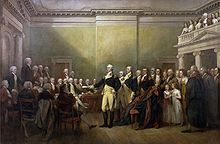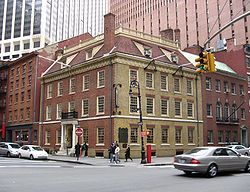This is your morning Open Thread. Pour your favorite beverage and review the past and comment on the future
Find the past “On This Day in History” here.
December 7 is the 341st day of the year (342nd in leap years) in the Gregorian calendar. There are 24 days remaining until the end of the year.
On this day in 1787, (In) Dover, Delaware, the U.S. Constitution is unanimously ratified by all 30 delegates to the Delaware Constitutional Convention, making Delaware the first state of the modern United States.
Less than four months before, the Constitution was signed by 37 of the original 55 delegates to the Constitutional Convention meeting in Philadelphia. The Constitution was sent to the states for ratification, and, by the terms of the document, the Constitution would become binding once nine of the former 13 colonies had ratified the document. Delaware led the process, and on June 21, 1788, New Hampshire became the ninth state to ratify the Constitution, making federal democracy the law of the land. Government under the U.S. Constitution took effect on March 4, 1789.
Delaware is a U.S. state located on the Atlantic Coast in the Mid-Atlantic region of the United States. The state takes its name from Thomas West, 3rd Baron De La Warr, an English nobleman and Virginia’s first colonial governor, after whom (what is now called) Cape Henlopen was originally named.
Delaware is located in the northeastern portion of the Delmarva Peninsula and is the second smallest state in area (after Rhode Island). Estimates in 2007 rank the population of Delaware as 45th in the nation, but 6th in population density, with more than 60% of the population in New Castle County. Delaware is divided into three counties. From north to south, these three counties are New Castle, Kent, and Sussex. While the southern two counties have historically been predominantly agricultural, New Castle County has been more industrialized.
The state ranks second in civilian scientists and engineers as a percentage of the workforce and number of patents issued to companies or individuals per 1,000 workers. The history of the state’s economic and industrial development is closely tied to the impact of the Du Pont family, founders and scions of E. I. du Pont de Nemours and Company, one of the world’s largest chemical companies.
Before its coastline was first explored by Europeans in the 16th century, Delaware was inhabited by several groups of Native Americans, including the Lenape in the north and Nanticoke in the south. It was initially colonized by Dutch traders at Zwaanendael, located near the present town of Lewes, in 1631. Delaware was one of the thirteen colonies participating in the American Revolution and on December 7, 1787, became the first state to ratify the Constitution of the United States, thereby becoming known as The First State.
Delaware is the home state of Vice President Joseph Biden




 Marlon Brando‘s famous cry of “STELLA!” first booms across a Broadway stage, electrifying the audience at the Ethel Barrymore Theatre during the first-ever performance of Tennessee Williams‘ play A Streetcar Named Desire.
Marlon Brando‘s famous cry of “STELLA!” first booms across a Broadway stage, electrifying the audience at the Ethel Barrymore Theatre during the first-ever performance of Tennessee Williams‘ play A Streetcar Named Desire. An energy-trading company based in Houston, Texas, Enron was formed in 1985 as the merger of two gas companies, Houston Natural Gas and Internorth. Under chairman and CEO Kenneth Lay, Enron rose as high as number seven on Fortune magazine’s list of the top 500 U.S. companies. In 2000, the company employed 21,000 people and posted revenue of $111 billion. Over the next year, however, Enron’s stock price began a dramatic slide, dropping from $90.75 in August 2000 to $0.26 by closing on November 30, 2001.
An energy-trading company based in Houston, Texas, Enron was formed in 1985 as the merger of two gas companies, Houston Natural Gas and Internorth. Under chairman and CEO Kenneth Lay, Enron rose as high as number seven on Fortune magazine’s list of the top 500 U.S. companies. In 2000, the company employed 21,000 people and posted revenue of $111 billion. Over the next year, however, Enron’s stock price began a dramatic slide, dropping from $90.75 in August 2000 to $0.26 by closing on November 30, 2001.
 On this day in 1886,
On this day in 1886,  It opened on 2 May 1869 as the Folies Trévise, with fare including operettas, comic opera, popular songs, and gymnastics. It became the Folies Bergère on 13 September 1872, named after a nearby street, the rue Bergère (the feminine form of “shepherd”).
It opened on 2 May 1869 as the Folies Trévise, with fare including operettas, comic opera, popular songs, and gymnastics. It became the Folies Bergère on 13 September 1872, named after a nearby street, the rue Bergère (the feminine form of “shepherd”). On this day in 1963, one week after President John F. Kennedy was fatally shot while riding in a motorcade in Dallas, Texas, President Lyndon Johnson establishes a
On this day in 1963, one week after President John F. Kennedy was fatally shot while riding in a motorcade in Dallas, Texas, President Lyndon Johnson establishes a 

Recent Comments